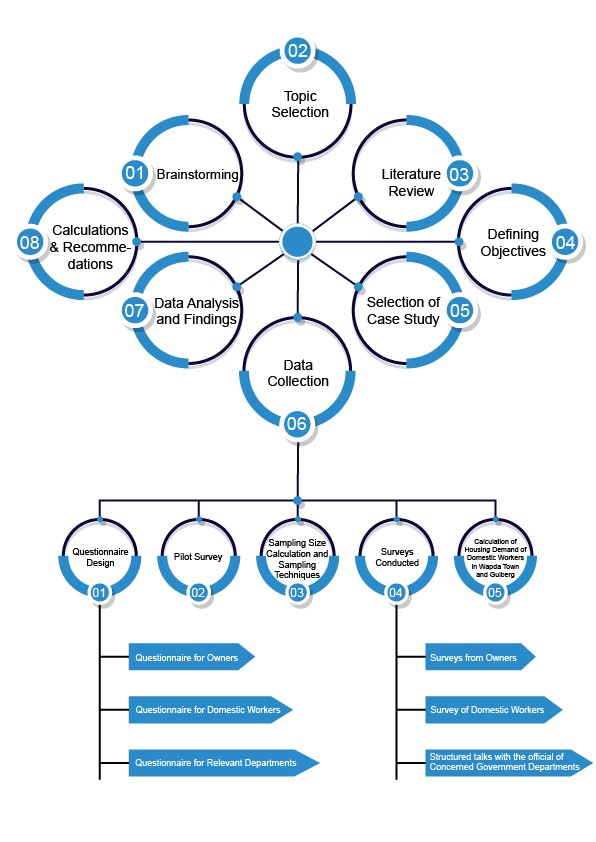Empirical Assessment for the Domestic Worker Housing: A Case Study of Lahore
Keywords:
housing provision, domestic workers, accommodation, demand, LahoreAbstract
A house is considered a basic human need. It provides identity, security, belonging, and privacy. Regrettably, Pakistan is facing a housing backlog of almost 10 million units. This research aims to diagnose the problems related to accommodation that domestic workers are facing and to assess the pragmatic options for housing the labor class groups. Data for this research was collected from the residents, domestic workers, and relevant authorities through a structured questionnaire survey in selected case study areas. The dependent variable in the study is the provision of accommodation to the domestic workers, which needs to be calculated. The predictors or independent variables are affordability of domestic workers’ residence, salary, housing provision, financial status, and role of government. The results reveal that when “provision of housing allowance” to the domestic workers will help in overcoming the problem of housing available to the workers Its value goes up by 1, “provision of residence to domestic workers at nearby places” increases by 0.518 Similarly, “provision of nearby residence increases the work efficiency” goes up to 1, “provision of residence to domestic workers at nearby places” goes up by the value 0.118.
Analysis revealed that workers’ work efficiency depends upon, Government and financial support from the people. The findings of the study/research analysis revealed that most domestic workers are being deprived of livable housing and have to bear significant travel expenses to reach their workplaces. There is a dire need to form a government-based strong association for the domestic worker which would work for the betterment of domestic workers to improve their quality of life. The government and private developers should increase the supply of low-income housing in the form of vertical growth development. It can be pertinent to propose that housing opportunities have to be placed close to the vicinity of workplaces to reduce the travel cost bear by domestic workers.
References
World Economic Forum, The Global Competitiveness Index Report 2017-2018. 2018.
J. Cock, “Trapped workers: The case of domestic servants in South Africa,” Patriarchy Cl. African Women Home Work., pp. 205–220, Jan. 2019, doi: 10.4324/9780429301155-10.
“Domestic Workers: Giving rights to millions of domestic workers in Pakistan.” https://www.ilo.org/islamabad/info/public/fs/WCMS_347029/lang--en/index.htm (accessed Jun. 24, 2022).
M. Ishii et al., “Space weather benchmarks on Japanese society,” Earth, Planets Sp., vol. 73, no. 1, pp. 1–20, Dec. 2021, doi: 10.1186/S40623-021-01420-5/TABLES/3.
B. Bersaglio, C. Enns, and T. Kepe, “Youth under construction: the United Nations’ representations of youth in the global conversation on the post-2015 development agenda,” http://dx.doi.org/10.1080/02255189.2015.994596, vol. 36, no. 1, pp. 57–71, Jan. 2015, doi: 10.1080/02255189.2015.994596.
I. A. Rana and S. S. Bhatti, “Lahore, Pakistan – Urbanization challenges and opportunities,” Cities, vol. 72, pp. 348–355, Feb. 2018, doi: 10.1016/J.CITIES.2017.09.014.
A. M. Islam. S. H, Mayo. M. S, Rahman.A, Afzal. U, “Determination and Mitigation of Urban Heat Island (UHI) In Lahore (A comparative Study of Landsat 8&9),” I nternational J. Innov. Sci. Technol., vol. 4, no. 2, pp. 526–551, 2022.
S. Banerjee and D. Govil, “Bengali Female Migrants: Domestic Workers in Mumbai,” ANTYAJAA Indian J. Women Soc. Chang., vol. 3, no. 2, pp. 194–206, 2018, doi: 10.1177/2455632718798071.
F. T. J. Malit and S. Ghafoor, “Domestic Work Legislation in the Gulf Countries: A Comparative Policy Review,” Int. Assoc. Int. Gulf Organ., no. August, 2016, doi: 10.13140/RG.2.2.32072.52483.
P. A. Cawood and C. J. Hawkesworth, “Continental crustal volume, thickness and area, and their geodynamic implications,” Gondwana Res., vol. 66, pp. 116–125, Feb. 2019, doi: 10.1016/J.GR.2018.11.001.
Shakir. M. M. ZaheerH, “A Study of Reasons behind Unproductivity and In-decisiveness in public Institutions of Urban Planning in Pakistan,” I nternational J. Innov. Sci. Technol., vol. 4, no. 2, pp. 564–577, 2022.
V. Desai, “Urban widows: living and negotiating gendered dispossession in speculative slum housing markets in Mumbai,” https://doi.org/10.1080/0966369X.2020.1811642, vol. 28, no. 10, pp. 779–799, 2020, doi: 10.1080/0966369X.2020.1811642.
E. JANSEN, “Like Family,” Apr. 2019, doi: 10.18772/12019043511.
J. S. I. Dodíaz, “The Trade in Domestic Servants (Morianer) from Tranquebar for Upper Class Danish Homes in the First Half of the Seventeenth Century,” Itinerario, vol. 43, no. 2, pp. 194–217, Aug. 2019, doi: 10.1017/S0165115319000238.
S. Ghosh, “DAILY LIFE OF WOMEN : An Encyclopedia from Ancient Times to the Present,” no. March, 2021.
S. S. A. Khurshid. M, “Assessment and Validation of Land Surface Temperature (LST) Dynamics using Geo-spatial Techniques in Dera Ghazi Khan City, Pakistan,” I nternational J. Innov. Sci. Technol., vol. 4, no. 2, pp. 300–312, 2022.
N. Sinha, N. Varma, and P. Jha, “Servants’ pasts.”
“Lahore (District, Pakistan) - Population Statistics, Charts, Map and Location.” https://www.citypopulation.de/en/pakistan/distr/admin/716__lahore/ (accessed Jun. 24, 2022).
F. Wagman Roisman, “Stumbling Stones at Levittown: What to Do About Racial Covenants in the United States,” Accessed: Jun. 24, 2022. [Online]. Available: https://www.mappingsegregationdec.org.
M. Klimaszewski, “Servants and Collaborative Storytelling Space in The Haunted House,” Victorians A J. Cult. Lit., vol. 140, no. 1, pp. 115–125, 2021, doi: 10.1353/VCT.2021.0012.
L. Ernst, “Domestic Workers in Hong Kong : Their Stories , Self-Perception , and Their Portrayal in Hong Kong and Filipino Media,” 2018.
T. A. Grose, “If you don’t know how, just learn: Chinese housing and the transformation of Uyghur domestic space,” https://doi.org/10.1080/01419870.2020.1789686, pp. 1–22, 2020, doi: 10.1080/01419870.2020.1789686.
N. Theodore, B. Gutelius, and L. Burnham, “Workplace Health and Safety Hazards Faced by Informally Employed Domestic Workers in the United States,” Work. Heal. Saf., vol. 67, no. 1, pp. 9–17, Jan. 2019, doi: 10.1177/2165079918785923.

Published
How to Cite
Issue
Section
License
Copyright (c) 2022 50sea

This work is licensed under a Creative Commons Attribution 4.0 International License.




















